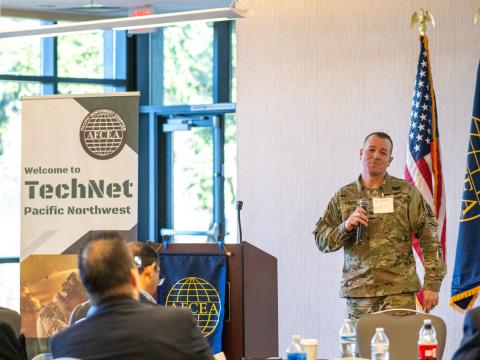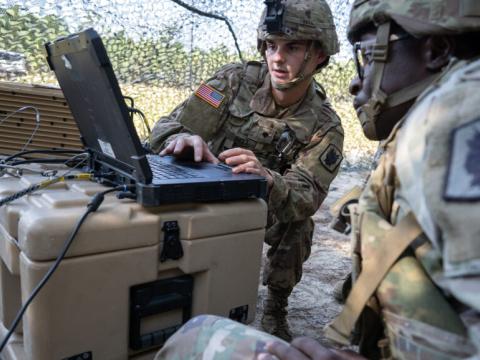Communications Under Fire
Technical specialists work on-point for the nation.
In the war against terrorism, ship and aircraft activity may be foremost on the nightly news and in the public eye, but in information-age conflicts an almost invisible force is just as critical to mission success. The military service members who build communications infrastructure from the ground up under combat conditions have become major contributors to winning battles fought by joint and coalition forces.
When 1st Lt. Julie Bresciani, USA, of the 11th Signal Brigade, Fort Monmouth, New Jersey, felt the jolt of the C-130 aircraft landing in Afghanistan last November, it was the beginning of her team’s mission to create a worldwide network to allow U.S. and international forces to communicate and start dismantling a terrorist regime.
It was late in the evening when the team began the landing process over the Bagram Air Base, Afghanistan. About 15 minutes before landing, the aircraft’s lights went out and the red lights came on, signifying blackout mode. It was going to be a combat landing.
As the aircraft touched down, the crew members were already moving through the plane getting the equipment ready to be offloaded. When the tail dropped and they began exiting, the lieutenant’s team, which was the first echelon-above-corps signal unit to arrive in Afghanistan, looked out for a view of the area only to see darkness. It was broken by the single chemlight of a soldier who told Lt. Bresciani and her crew to stay in a single file and follow the light so they did not wander off the tarmac and into surrounding minefields.
The signal soldiers started setting up their equipment throughout the U.S. Central Command (CENTCOM) area of operations and quickly created a network backbone. The infrastructure allows instant voice, video and data communications for commanders on battlefields that stretch across the globe to higher headquarters and rear detachments in the United States.
For Sgt. 1st Class Steven L. Musik, USA, platoon sergeant from Company B, 86th Signal Battalion, Fort Huachuca, Arizona, and his team of about 10 soldiers who arrived in Kandahar, Afghanistan, in early January, the deployment included rough living conditions and the dangers of sniper fire.
The team’s mission grew as time passed. Instead of just supporting the 3rd Brigade, 101st Airborne Division, the 11th Signal Brigade created the communications network to support the entire base, including the coalition forces.
For senior leaders, the signal crews and their equipment were a welcome sight. One senior leader in the CENTCOM area says that before the signal soldiers set up their communications, he was “staring at four walls.” Over the next few months, the 11th Signal Brigade continued sending teams across Afghanistan and other nearby countries to build communications networks to ensure that critical voice, video and data information could smoothly flow around the world.
Capt. Cole A. Hanson, USA, 11th Signal Brigade information management officer, explains that today’s technical capabilities fundamentally affect the way battles are fought. “We have seen, in my opinion, quite a divergent change in how we communicate. Commanders are relying heavily on e-mail to send orders down to their subordinate commanders. The whole operation has become very data intensive,” he says.
The importance of electronic communications became clear, the captain offers, when a senior leader at one of the main Afghanistan camps came into the signal area and said, “It’s great I have phones, but where’s my data?”
Because of this increased communications demand, Capt. Hanson says the brigade deployed with a different mission than it had ever faced before. In the past, the 11th Signal Brigade did not act as an Internet service provider at individual locations. Until September 11, 2001, the brigade’s mission was to deploy data packages to the user. The users would then come to the brigade network and plug in, set up and manage their own communications. The brigade only provided the links for the units.
When the brigade deployed in support of operation Enduring Freedom, however, the soldiers were prepared not only to set up the communications backbone, but also to tackle the mission of administering the local area networks and furnishing service right down to the laptop, Capt. Hanson explains. This marked the first time the brigade deployed and provided this type of in-depth service, and it was a big undertaking.
“When you step back and look at the network that we designed and put together, it was mammoth,” he says. “We went from PC to satellite, and there’s no unit that I’ve seen that goes to that extreme.”
To handle the expanded communications mission, signal units came to the battlefield armed with high-technology communications equipment and soldiers with the skill and adaptability to troubleshoot and change missions without letting the warfighters fall out of the communications loop, he adds.
Coming into an area and giving commanders the ability to video teleconference with their leaders halfway around the world or to receive real-time information and orders from the secure Internet is a big change from the services available during Desert Storm, Sgt. Musik relates. Today’s equipment is not only about 10 times faster, it also is smaller, less bulky and more mobile, he says.
However, Maj. Gen. James C. Hylton, USA, commanding general, U.S. Army Signal Command, Fort Huachuca, Arizona, shares that while the communications technology available to the military today gives U.S. forces an advantage, the skill and dedication of the soldiers make the difference.
“Our single reason for success—not that the technologies are not important, because clearly they are—but the key to our success to date has been the great soldiers and leaders who are on the ground, who are skilled, dedicated, professionally competent, adaptive to change and can deliver the critical C4 [command, control, communications and computers] capabilities required to be successful in the complex coalition environment of today,” Gen. Hylton contends.
“This support is critical,” Sgt. Musik says. “It can be life or death, and we know that. The message has to go through.”
Staff Sgt. Timothy Volkert, USA, is a journalist with the U.S. Army Signal Command.




Comments